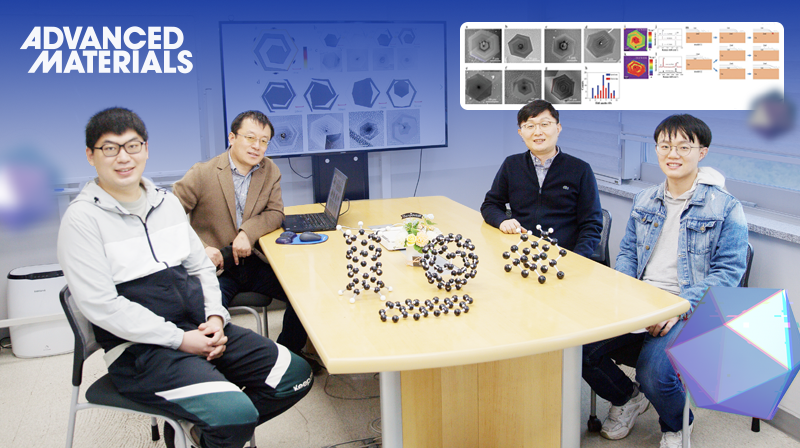In history, the synthesis of key materials, such as bronze, steel, polymer, and silicon, represents the most advanced technology of human society. Until now, the discovery of a new material and the development of materials highly depends on the experiences gained by a huge number of experimental tries and thus are very timing consuming. Controllable materials design and synthesis guiding by theories can greatly accelerate the discovery and development of new materials and thus is the dream of scientists and engineers for many centuries. Yet, due to the limited understanding on the mechanisms of materials synthesis, it has never been fully realized. In a recent publication (https://doi.org/10.1002/adma.202107587), Distinguished Professor Feng Ding and Professor Zonghoon Lee of Ulsan National Institute of Science and Technology (UNIST) and Institute for Basic Science (IBS) and their colleagues demonstrated an example of controllable synthesis of graphene via a theoretical understanding of the growth mechanism and paves a way for the fast synthesis of better materials in the future guided by theoretical study.

Figure 1. The different morphologies of second layer graphene spirals.
Recently, Distinguished Professor Ding and his colleagues synthesized a series of multi-layer graphene spirals, or spiral sharped graphene arms beneath hexagonal graphene islands (See Figure 1). These graphene spirals have several distinguishable features: (i) they are add-layer graphene grown beneath a graphene hexagon; (ii) a graphene spiral may have 1, 2, 3, 4, 5, 6 spiral-shaped arms; (iii) The tip of a spiral graphene arm always in contact with the edge of first hexagonal graphene layer. The growth of spiral shaped materials has never been observed in other materials before and, thus, its growth cannot be understood by any traditional theory of materials. Besides, the observation of the graphene spirals shows a distinct difference between the growth of first layer graphene and the second layer graphene and a deep theoretical understand on it may lead to a solution towards the thickness controllable graphene growth, which is a long term daunting problem of graphene synthesis.

Figure 2. Characterization of a single-spiral graphene island grown on Cu foil.
With extensive experimental characterizations of the grown materials and theoretical efforts, the authors finally were able to simulate the spiraled graphene growth by a kinetic Monte Carlo (kMC) method and unveiled the growth mechanism of the spiral graphene adlayer structure.
“The growth of graphene adlayers in the form of spiral shape is due to the limited carbon precursor diffused from the edge of the first graphene layer. If the amount of carbon precursors beneath the first graphene layer is not enough to grow a complete graphene layer, the adlayer graphene will cover a fraction of the beneath area with a specific pattern, such as the observed spiraled graphene arms. The concentration of the precursors is higher at the edge of the first layer graphene and thus the tip of a graphene spiral always attached to the edge of the first graphene layer to scavenge the precursors diffused from the edge of the first layer graphene,” Explained Dr. Xiao Kong, the first author of the paper.
The kinetic Monte Carlo simulation developed by Professor Ding’s research group perfectly reproduced all these observations and provides an intuitive picture to the growth mechanism (Figure 2). The kMC simulation movies can be found on the publication website or the YouTube channel of Dr. Xiao Kong, as follows.
“The growth mechanism helps us to understand the role of carbon precursor feeding graphene growth. If we can control the feeding of carbon precursors during graphene growth, we should be able to control the thickness of graphene precisely. Therefore, our results thus provide a new way to the controllable growth of multilayer graphene,” Added Professor Ding.
During the study, the characterization of the samples plays an central role, the precise characterizations of the samples by high resolution transmission electron microscopy (HRTEM) by Professor Lee’s group provides the key information of the graphene spiral structure and led to the complete theoretical understanding on the growth mechanism.
This research has been published in the online version of Advanced Materials on January 19, 2022. This work has been supported by the Institute for Basic Science (IBS), South Korea. It has also been jointly participated by Professor Zonghoon Lee (MSE, UNIST).
Feng Ding
Distinguished Professor, School of Materials Science and Eng., UNIST
IBS Center for Multidimensional Carbon Materials (CMCM)
Story Source
Materials provided by the Institute of Basic Science.
Notes for Editors
This press release is made available courtesy of IBS Communications Team.
Journal Reference
Haibin Sun, Xiao Kong, Hyoju Park, et al., “Spiral Growth of Adlayer Graphene,” Advanced Materials, (2022). DOI: https://doi.org/10.1002/adma.202107587














